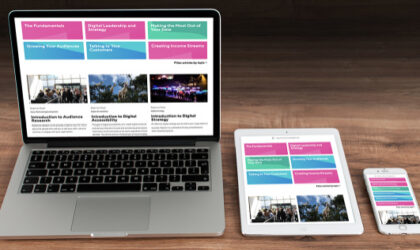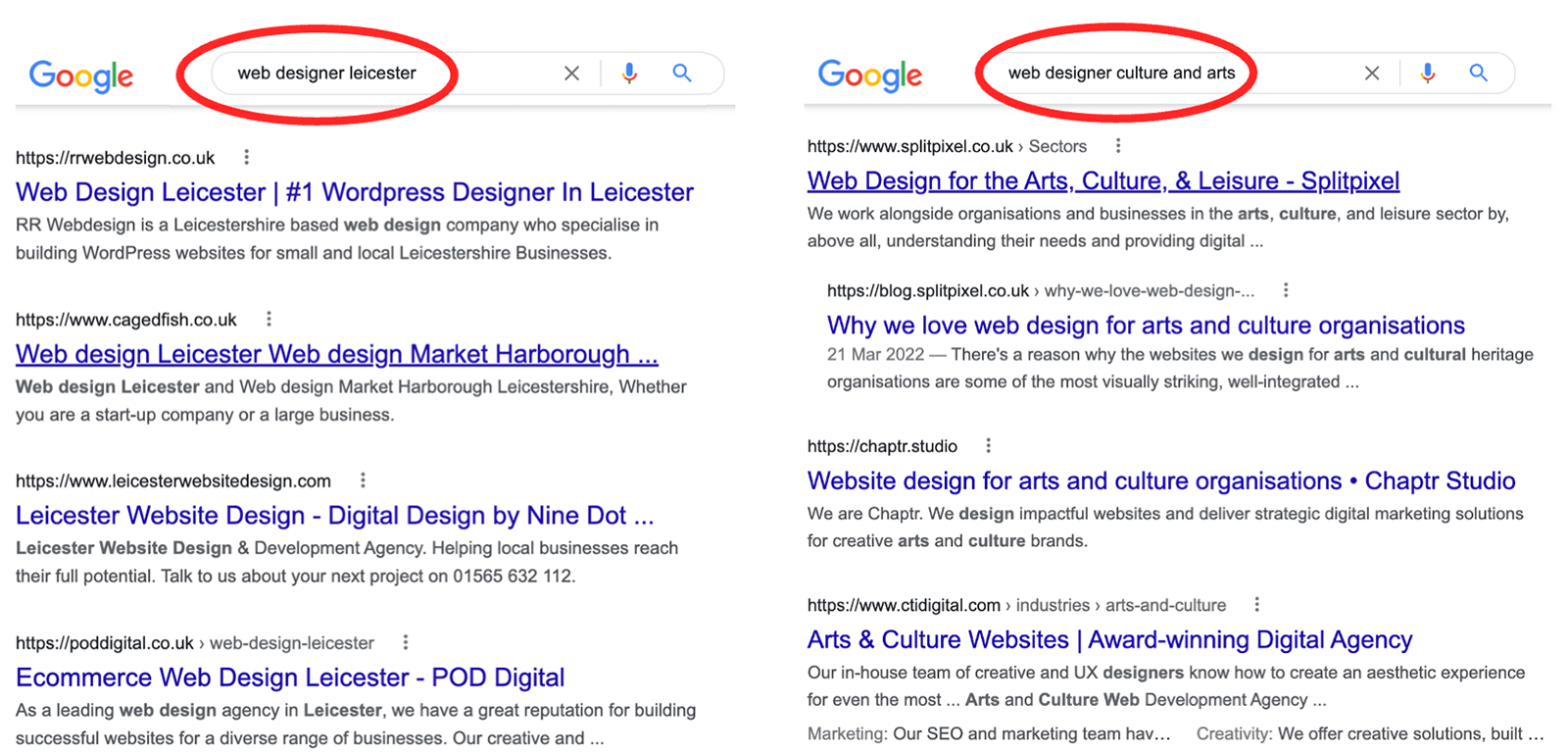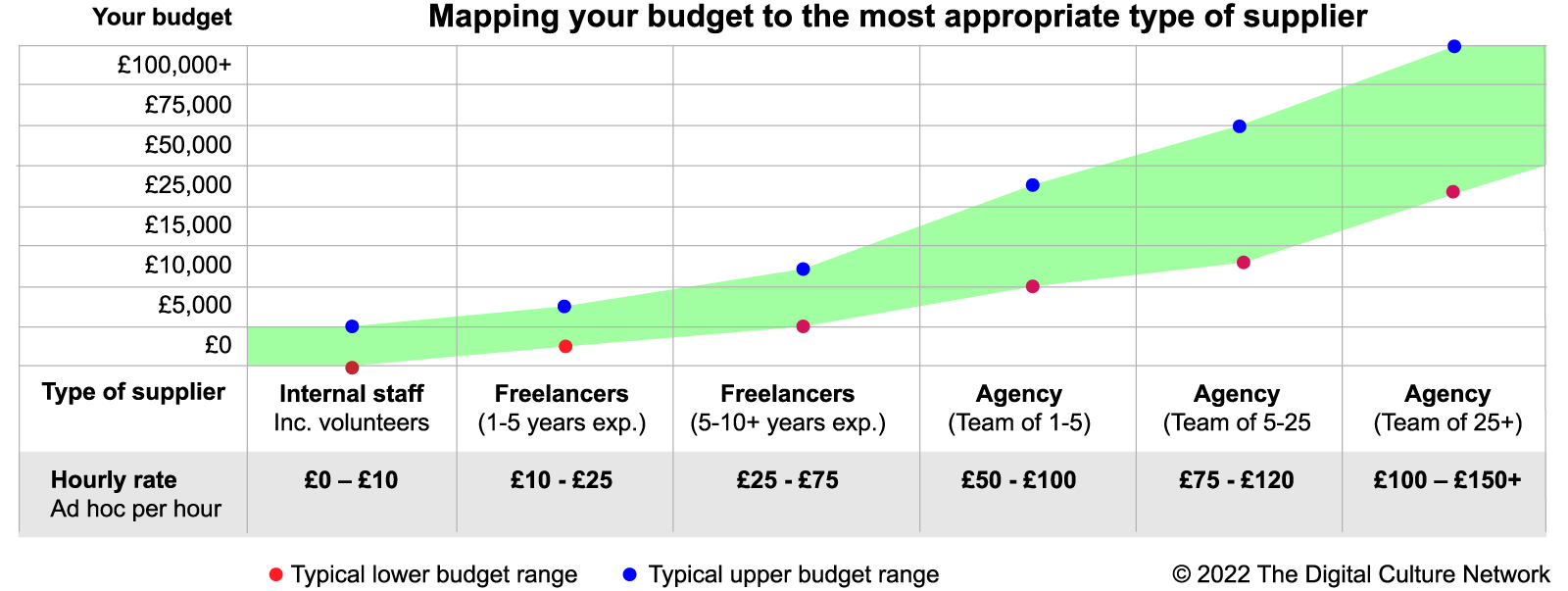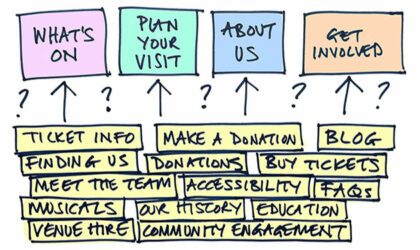
Beginner Read Digital Strategy Websites
Your website is one of your most important assets. Read on to find out how it can make a big impact on your organisation.
In this article
This article accompanies and complements the webinar of the same title presented by Tech Champion Andy Leitch on November 7th, 2022. A recording of this webinar can be viewed here.
Aimed at creative and cultural organisations or individual practitioners who are planning to redesign or improve their website, we will cover how to select the right agency, designer or developer (supplier) for your next website project. We will answer the question – ‘How do I find and commission the ideal company or individual for my requirements and budget?’
In a rush? Here is one key takeaway… as with any product or service you invest in, you generally get what you pay for. That goes for your website too.
For those of you who are sticking with me, this article is divided into 5 digestible chapters after a short introduction:
According to the Oxford English Dictionary, a supplier is a person or organisation that provides something needed, such as a product or a service. There are a multitude of names or labels for suppliers who create web sites. For the purposes of this article, we will use ‘supplier’ as a catch-all term, meaning an individual (freelancer) or a company (or agency)

The process of planning a website project is an article in itself. Indeed there are other resources within our Knowledge Hub you could read on this topic (a couple are highlighted at the end of this article). In summary, there are 4 main considerations when planning a website project which are;
1. Objectives and purpose |
2. Stakeholder agreement |
|||
| • Sell more tickets? | • CEO and The board | |||
| • Raise your organisation’s profile? | • Trustees and Patrons | |||
| • Raise funds? | • Your staff | |||
| • To reflect rebranding? | • Your customers/audience | |||
3. Budget and timescales |
4. Prepare project brief |
|||
| • How much can we afford? | • Objectives | |||
| • When do we need the site live? | • Functionality / integrations | |||
| • What about support post launch? | • Design preferences | |||
| • Do we have internal resources? | • Budget and timescales | |||
You may have an existing supplier. You may or may not be happy with their service. Ask yourself, are they easy to work with? Are they responsive to your requests? Do they provide proactive suggestions and recommendations? Do they offer good value and high quality? If the answer is yes, you may decide to abandon the search for a new supplier and stick with what you know, which is fine or, you may, out of courtesy, invite them to pitch/provide a proposal along with two or three alternative suppliers to get a comparison.
To kick off the process, we create a long list of potential suppliers. You could log them in a spreadsheet, or if you prefer jot them down on paper, whatever you prefer. There are three things you can do to get started.
Reach out to contacts in the creative and cultural sector – ask them who designed their website and whether was it a good experience. Post a message on your social channels requesting recommendations for great web designers or digital agencies. If you use LinkedIn, this is ideal as you can limit visibility to your network of contacts – people you know and trust. You can also ask around more generally – family and friends. Who designed your website?
Use Google to do some research. You can use search terms to filter your results, by location (e.g. web designer Leicester), sector (e.g. web designer culture and arts) or more surgically your art form (e.g. web designer Dance production). The latter will result in suppliers with specific experience in that art form. Follow the links and if you like what you see, add them to your list.

Many suppliers will agree a discreet website credit/link from the organisations they work with. This is usually located at the very bottom of that organisation’s webpages. Find websites you like and follow the link to review the supplier’s website. If they look good to you, add them to your list.

There are also numerous online indexes of website freelancers and agencies you could have a look at. Clutch is an example. Its supplier database can be filtered by location, sector and budget. Upwork is another option – a directory of freelancers and agencies. If you’re really strapped for cash, you can try Fiverr – a global listing of suppliers. Be mindful that suppliers pay for inclusion in most of these indexes and as such they are not a guarantee of quality or reliability.
The Arts Marketing Association (AMA) also has a directory of sector professionals you could try.
Get in touch with The Digital Culture Network – we have an evolving list of suppliers with sector knowledge that we can introduce you to – contact us today.
So, you’ve pulled together a list of potential suppliers. Next we need to vet them and reduce this down to a shortlist. Below are some criteria for you to consider. The importance of these will differ between organisations.
As covered above, you may wish to only approach suppliers that are local to you. This makes face-to-face meetings easy if that is your preference. It is easy enough to work out where suppliers are located by looking at their contact page or their listing on Google (the information displayed on the right-hand side of a search results page). Post-pandemic a lot of suppliers are moving to a more remote working model, so do not be surprised if their staff are located at different ends of the country!
I would say a supplier with a track record within the arts, creative and cultural sectors is an advantage, particularly if they can provide examples of working with organisations such as yours. This experience gives them a head start in understanding you and the common pain points and objectives you may have. So look for evidence in the work or case study sections of their website. Also, keep an eye out for the results of their work – this could be shown as statistics or testimonials.

What you have to spend and what the supplier deems to be commercially viable needs to be considered. If you have a £1,000 budget, it’s unlikely a large agency would be interested in designing your website. Conversely, I would not recommend you commission a freelancer to deliver a large-scale project of £50,000. So how can you judge the size of the supplier and hence their suitability to work with you? In simple terms, there are two categories of suppliers to consider, summarised below:

Individual web designers/developers (freelancers)
Freelancers have low overheads, so offer good value if your budget is small. They typically charge by an hourly or daily rate (£200 – £500 a day is fairly typical) based on experience, location and skillset. They may provide a fixed price for your project based on your brief. The downside is they are on their own, so may be difficult to get hold of when they are working on other client projects, unwell, or on holiday.
Web teams / companies (agencies)
An agency will vary in size and will have multiple staff with skills in different areas (creative, technical, account management etc). Agencies have higher overheads and salaries to pay, and hence, are more expensive. They are however set up for larger projects and can offer more than one point of contact to assist with project communication.
Which ever you choose, make sure you check out their website and look at their work, as described above.

Alongside the website project, are there other related services you need? For example:
If the answer is yes, review the supplier websites to see if the services you need are featured and if they can evidence work examples for those services.
This is really important. It is about selection based on the supplier’s values and how they align with your own. Look at their website, in particular the about section, blog and social media content – do they look like the kind of person/team that you would be comfortable working with? See if they are listed on Glass Door – what do former employees say about them? You want this project to be a good experience, so getting the relationship right is a key component.

Larger companies may have accreditations that reflect your own values – these are usually located on their website footers or within their about sections.
It is likely, diversity forms part of your organisational ethos, in which case you will want to engage with suppliers who reflect your own diversity values. That is something that you might want to consider as part of your decision‑making process. Have a look at their team page – do they look like the kind of people you see yourself working with?
If you are a National Portfolio Organisation (NPO), you will be aware of our commitment to the environment and to reducing our carbon footprint. This extends to the organisations we support, and their supply chain – this includes websites! So the environmental credentials of the suppliers you are shortlisting will be a consideration. Have a look at their website footer, about pages, blog, and social media output to find evidence of their environmental efforts. Do they tally with yours?
By undergoing this supplier evaluation process, you will likely find yourself leaning toward particular suppliers. You may not be able to put your finger on what attracts you to a particular supplier but that is OK – trust your instinct and shortlist the suppliers that ‘just feel right’.
So you have invested the time vetting the suppliers you have sourced or been recommended. Now you have a shortlist of 4 or 5 to contact. The first step is to gauge their interest. You can do this by phone or email. Summarise your website project and be open about your budget. What you have to spend may not be commercially viable for them so do not be surprised if the larger suppliers on your list politely decline.
For those suppliers interested in your project, arrange a ‘meet and greet’ in person or online. At their premises is ideal so you can get a good feel of their culture and set up. Find out more about them and their work, and use this opportunity to ask questions to confirm what you have learned about them via their website. Make notes and think is this a supplier I could work with?
They will no doubt also want to ask questions about the project and potentially challenge your thinking. Be honest and open with them. Also, make sure you discuss their approach to post-launch support and how they typically work with their clients long-term.
At this point, having met or spoken to the suppliers you can make a definitive decision on who you want to invite to the process. These are your options:
These are the key questions to ask yourself:
Of course, for free guidance and reassurance, ask us at The Digital Culture Network. We have bags of experience. We can cast an eye over the supplier proposals received and give impartial advice to you.
Finally, request a formal statement of work, a document signed by the supplier and yourselves that lists all activities they will undertake for the website project and the costs agreed. If you feel anything is missing, discuss it with them before you kick off the project.
Your choice of supplier should be influenced in part by how they work with their clients post-launch (after the website has been completed). Getting a great website is all well and good, but it needs to be properly supported and maintained long-term. Ensure you have budgeted for this. Think of the supplier as a partner and keep them up to date with any changes to your organisation. Invite them to contribute ideas going forward on how the website could be improved, or for associated activity such as campaign ideas or improving your placement within Google search results.
One final thought…
As with the purchase of any product or service, you generally get what you pay for!
The Digital Culture Network is here to support you or your organisation. Our Tech Champions can provide free 1-2-1 support to all creative and cultural individuals and organisations who are in receipt of, or eligible for, Arts Council England funding. If you need help or would like to chat with us about any of the advice we have covered above, please get in touch. Sign up to our newsletter below and follow us on Twitter @ace_dcn and LinkedIn for the latest updates.
Related content by topic
The Fundamentals website website design website development agency supplier freelancer
Beginner Read Digital Strategy Websites
Your website is one of your most important assets. Read on to find out how it can make a big impact on your organisation.
Beginner Read Websites
Whether you're creating a brand-new site or reviewing your existing web presence completely, here are some recommendations for making your website as effective as possible.
Beginner Read Websites
Could your website be working harder for you? Our checklist will help you assess and improve your activities
Beginner Read Digital Strategy Websites
Your website is one of your most important assets. Read on to find out how it can make a big impact on your organisation.
Beginner Read Websites
Tree testing is a quick and easy way to test the effectiveness of your website navigation. It’s a technique that can also test a new website structure you may be planning. A tree test can confirm how easy (or difficult!) it is to find important information on your website. This article by Andy explains it all.
Beginner Read Data Analytics and Insight Search Engine Optimisation Websites
This article is aimed at anyone who wants to improve the effectiveness of their website and improve the experience of their website visitors.



